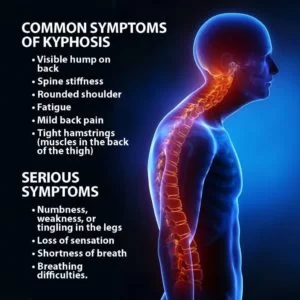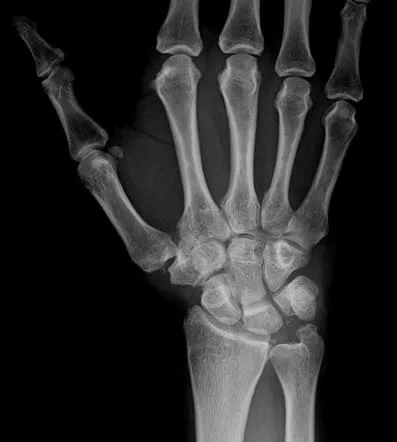Kyphosis
What is a Kyphosis?
Kyphosis is a Postural-spinal disorder in which an excessive outward curve of the spine results in an abnormal rounding of the upper back. The condition is sometimes known as “roundback” or—in the case of a severe curve—as “hunchback.”
Kyphosis can occur at any age, but is common during adolescence.
A patient may need Regular exercise and to wear a back brace in order to improve his or her posture. In severe cases, however, kyphosis can be painful, cause significant spinal deformity, and lead to breathing problems. Patients with severe kyphosis may need surgery to help reduce the excessive spinal curve and improve their symptoms.
Anatomy Of Cervical, Thoracic, And Lumbar Spine :

The normal anatomy of the spine is usually described by dividing up the spine into three major sections:
- the cervical: There are 7 cervical vertebrae
- the thoracic: 12 thoracic vertebrae
- the lumbar spine: 5 lumbar vertebrae.
(Below the lumbar spine is a bone called the sacrum, which is part of the pelvis).
Each section is made up of individual bones, called vertebrae.
The normal spine has an S-shaped curve when viewed from the side. This shape allows for an even distribution of weight and flexibility of movement. The spine curves in the following ways :
- The cervical spine curves slightly inward, sometimes described as a backward C-shape or lordotic curve.
- The thoracic spine curves outward, forming a regular C-shape with the opening at the front—or a kyphotic curve.
- The lumbar spine curves inward and, like the cervical spine, has a lordotic or backward C-shape.
The curves of the spine can be exaggerated in any plane, leading to pain, deformity and neurologic dysfunction. Some abnormal curves are asymptomatic while other require treatment.
Common Postural-Spinal Deviation is Kyphosis, Scoliosis, Lordosis, and Flat Back.
Cause :

Kyphosis occurs when the vertebrae in the upper back become more wedge-shaped.
Abnormal vertebrae can be caused by:
- Fractures: Broken or crushed vertebrae (compression fractures) can result in curvature of the spine. Mild compression fractures often don’t produce noticeable signs or symptoms.
- Paralysis: Quadriplegia, Hemiplegia leads to weakness of the thoracic muscle and may lead to kyphosis.
- Osteoporosis: This bone-thinning disorder can cause spinal curvature, especially if weakened vertebrae result in compression fractures. Osteoporosis is most common in older women and people who have taken corticosteroids for long periods of time.
- Disk degeneration: Soft, circular disks act as cushions between spinal vertebrae. With age, these disks dry out and shrink, which often worsens kyphosis.
- Scheuermann’s disease: Also called Scheuermann’s kyphosis, this disease typically begins during the growth spurt that occurs before puberty. Boys are affected more often than girls.
- Birth defects: Spinal bones that don’t develop properly before birth can cause kyphosis.
- Syndromes: Kyphosis in children can also be associated with certain syndromes, such as Ehlers-Danlos syndrome and Marfan syndrome.
- Cancer and cancer treatments: Cancer in the spine can weaken vertebrae and make them more prone to compression fractures, as can chemotherapy and radiation cancer treatments.
TYPES OF KYPHOSIS
- Postural – it’s simply related to poor posture
- Structural – it involves part of the spine, and deformity in vertebrae.
- Primary Structural kyphosis : it include congenital kyphosis, Scheuermann’s kyphosis
- Secondary Structural Kyphosis : it include osteoporosis in the spine weaken, it may be due to primary condition.
Which Symptoms are seen in Kyphosis?

The signs and symptoms of kyphosis vary, depending upon the cause and severity of the curve. These may include :
- Rounded shoulders
- A visible hump on the back
- Mild back pain
- Fatigue
- Spine stiffness
- Tight hamstrings (the muscles in the back of the thigh).
Rarely, over time, progressive curves may lead to:
- Weakness, numbness, or tingling in the legs
- Loss of sensation
- Shortness of breath or other breathing difficulties
DIAGNOSIS:
Physical Examination :
- Observation
- Adam’s Forward Bending Test
- Palpation
- Range of Motion
- The doctor will generally conduct a thorough physical examination, including checking your height, Spinal curvature measurement, any tenderness, and muscle spasm examination is required. You may be asked to bend forward from the waist while your doctor views your spine from the side. Your doctor might also perform a neurological exam to check your reflexes and muscle strength.
Kyphosis is best seen from the side, both standing straight and bending forward.
Adam’s Forward Bending Test: in that, you bend forward at the waist. The doctor will look for a rounded curve (more indicative of postural kyphosis) or a more angular curve.
The angular curve can be called a gibbus deformity, and it’s easier to see when you bend forward.
It’s also easier for the doctor to see thoraco-lumbar kyphosis when you bend forward (thoraco-lumbar kyphosis is an abnormal curve in the region where the thoracic and lumbar spines meet).
To test your range of motion, your doctor will ask you to bend forward, backward, sideways, and twist. Some people with kyphosis find it hard to do these movements.
KYPHOSIS COBB’S ANGLE:-

After evaluating your signs and symptoms, your doctor may recommend:
X-rays: X-rays can determine the degree of curvature and detect deformities of the vertebrae. AP and PA and lateral view X-ray taken.
CT scan: might be recommended if your doctor wants more-detailed images.
MRI: These images can detect infection or a tumor in your spine.
Nerve tests (EMG/NCV): if numbness or muscle weakness is seen, the doctor may recommend tests to determine how well nerve impulses are traveling between your spinal cord and your extremities.
Bone density tests: Osteoporosis(Low-density bone) can worsen kyphosis and require these tests.
Pulmonary function tests: If the curve is severe, your doctor may order pulmonary function tests. These tests will help determine if your child’s breathing is restricted because of diminished chest space.
Treatment in Kyphosis :
Kyphosis treatment depends on the cause and severity of your condition.
The goal of treatment is to stop the progression of the curve and prevent deformity. Doctors will consider several things when determining treatment for kyphosis.
These factors are :
- Cause of Kyphosis
- Increasing Factor
- Your child’s age and overall health.
- The number of remaining growing years
- The type of kyphosis
- The severity of the curve
Medical Treatment :

To Relieve Pain: Mostly NSAIDS are used to relieve pain, and spasms of muscles.
Osteoporosis medications: Calcium (Bone-strengthening medications) may help prevent additional spinal fractures that would worsen your kyphosis.
Physiotherapy Treatment: Physical Exercise also helps to strengthen spinal muscles and also spine.
Braces: Braces help to stabilize the spine and helps to reduce curve over time.
PHYSIOTHERAPY MANAGEMENT:

Here we recommended a few exercises that are helpful to reduce curvature and strengthen the Thoracic spine Muscle And Also helpful to reduce osteoporosis.

- Cat and Camel Exercise
- Pelvic tilt
- Half butterfly
- Gluteal Muscle Stretch
- Quadruped arm and leg raise
- Side plank
- Chest up
- Arm support
- Bridging
- Hamstring and tendo-achillis muscle stretching
- Thoracic spine-Joint mobilization
- Postural braces.
Best Exercises to Fix Kyphosis Video
Surgical Treatment :
Surgery might be recommended for severe kyphosis that is pinching the spinal cord or nerve roots. Spinal fusion is the most common procedure for reducing the degree of curvature. The surgeon inserts pieces of bone between the vertebrae and then fastens the vertebrae together with metal rods and screws until the spine heals together in a corrected position.
Preventive Measure of Spine :
To help you maintain good bone density, proper muscle strength, doctor might recommend:
- Eating a diet rich in calcium and vitamin D
- Regular Physical Exercise that also strengthens spinal muscle
- Avoiding tobacco
- Limiting alcohol consumption







17 Comments